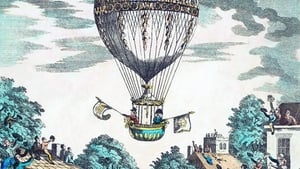Ratings
Series Details
Seasons: 1
Total Episodes: 13
Creators:
Networks:
Status: Ended
First Air Date: Jan 1, 2013
Recent Air Date: Jan 1, 2013
Run Time: m
In Production: No
Original Language: English
Age Rating: NR
Website: Link
Production Companies:
Genres
Keywords
People Rated This
None of your friends have rated this title yet
Watch The Amazing World of Aviation
Sorry! We currently don't have any streaming links for this tv show yet :(
Check back soon! We add new episodes every day!
Synopsis
No Synopsis for this season yet
Episodes

Episode 1
01 January 2013 - The Origins of Flight
From the exhilarating and perilous days of early flight, we explore the inspiration that drove such innovators as Benjamin Franklin and Leonardo Da Vinci who envisioned new ways to give man wings. From the invention of hot air balloons, Zeppelins and box kites to the most influental inventors of all - Wilbur and Orville Wright, two brothers from Midwestern America who were to have the biggest impact on the world of aviation.

Episode 2
01 January 2013 - Air Aces
The first decades of aviation brought both triumph and tragedy. A new breed of adventurers looked to the heavens for their challenges, and the advent of the movie camera meant that their exploits could be recorded for posterity. Several of the world's great aviators learned their craft in the bloodbath that was the Great War. The pilots of Germany, France and Britain who mastered the art of aerial combat become known as "Aces".

Episode 3
01 January 2013 - Aircraft Design
The decades following the First World War saw aircraft designers pushing the boundaries of aeronautical technology, moving the industry forward at a rapid pace. With new commercial markets opening up, it was the visionaries who held the key to success. Airplane production was moving away from an era where designers often built their own inventions, achieving a level of complexity which required specialist mechanics and engineers.

Episode 4
01 January 2013 - The Joy of Flying
The years following WWII saw flying become a business. Previously unimagined opportunities opened up, among them skywriting and sightseeing tours. Flying became a bigger feature of daily life around the world, not just as a novelty for rich people, but as a mode of transport available to almost everyone. And it's still the safest way to travel!

Episode 5
01 January 2013 - The Seaplane
With industry and tourism growing, it soon became apparent that planes would need to cross the oceans in order to transport passengers and cargo effectively. On 28th March 1910, Henri Fabre became the first person to successfully pilot a seaplane over water. Seaplanes heralded the dawn of the aviation industry, accommodating large numbers of passengers between continents and needing only a smooth body of water on which to land.

Episode 6
01 January 2013 - The Jet Age
In 1966, British aviation expert Sir Frank Whittle was honoured for his services to the aviation industry. Twenty-five years earlier, the aeronautical engineer had invented the jet engine, and ushered in a new era of air travel. On May the 15th, 1941, the first experimental flight using Whittle's engine took off over Cranwell, England and flew for 17 minutes, at a top speed of 545km per hour. It was the beginning of a revolution that would affect the very nature of aviation itself.

Episode 7
01 January 2013 - Highway in the Sky
The year 1950 was a pivotal year for innovations in air travel, marking the start of the Jet Age after the invention of the jet engine. Airlines began to spring up everywhere, catering to the demands of domestic passengers who wanted to go just about anywhere. Pre-war travel was sold as a luxury experience afforded only by the rich, but post war, the emphasis was on comfort and customer service for both the rich and middle class. Getting passengers from New York to London or Paris in less than seven hours was the biggest coup an airline could achieve.

Episode 8
01 January 2013 - Airports and Flight Attendants
The first air fields were more concerned with utility than comfort. In the early years, tents were the only amenities offered to enthusiasts. During the war, fields became runways, and hangars stored maintenance gear and airplanes. As the popularity of air transport increased, cities recognised the need to provide better service to passengers, and airports grew in design and sophistication becoming the hub of activity and convenience they are today with post offices, restaurants, shopping centers and hotels on site.

Episode 9
01 January 2013 - Supersonic Flight
Flying at the speed of sound during the 1960's didn't seem like the type of thing that was possible, but traditional rivals Britain and France collaborated to build and deliver the world's first Concorde, a jet that could traverse the Atlantic in just 3 hours, at twice the speed of sound. However, its inception wasn't without controversy. Britain and France squabbled over many aspects of its design, including the spelling of the name.

Episode 10
01 January 2013 - The Modern Age
The Boeing 737 twin engine jetliner was to become Boeing's greatest success. Launched in 1967, the short range transport has remained in production ever since. The 737 combined the best attributes of all previous Boeing aircraft including one of the lowest approach speeds of any jet transport and a simple refuelling process. However, despite all its advantages, the 737 was soon overshadowed by the new, improved 747 Jumbo Jet.

Episode 11
01 January 2013 - In for the Long Haul
As engines developed over time, airplanes were able to engage in longer flights. Traditionally, regulators had insisted that all passenger aircraft be powered by at least three engines. But the development of more sophisticated airplanes eventually made twin-engine, long-distance travel feasible. A new standard was introduced, known as Extended-range Twin-engine Operational Performance Standards, or ETOPS. Although some scares during the 1980s prompted people to question their capabilities, the long haul flight eventually became a time and cost-efficient reality.

Episode 12
01 January 2013 - The Giants of the Sky
In a bid to remain at the forefront of people's imaginations, airlines have continued to expand their fleet with new advanced models; two major contemporary competitors being the Airbus A380 and the Boeing Dreamliner. Similar to the Airbus A380, the plane is made from carbon fiber reinforced plastics and aluminum glass fiber materials which are lighter and more resistant to fatigue. It is one of many planes that have been developed to reduce the carbon footprint while improving space, comfort and entertainment for its passengers. Airports have also followed the trend becoming venues for reality TV, game shows, weddings and press conferences!

Episode 13
01 January 2013 - Air Travel Tomorrow
Once it was thought that flying was impossible, let alone trying to reach the moon. Today, space has become the domain of the public. No longer consigned to astronauts and scientists, space tourism is becoming a reality with corporations striving to be the first to take passengers into orbit. And with new enviromental technologies embracing modern aviation, space tourism may be a carbon neutral enterprise!
Crew
| Department | Role | Name |
|---|---|---|
| Department | Role | Name |
